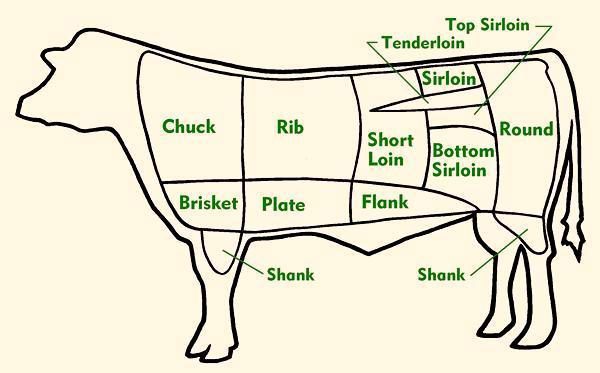Have you noticed how one of the year’s biggest food trends has been alternative meat cuts? During my recent visit to the U.S. I noticed how many restaurant menus featured new – and often affordable – cuts of meat, like tomahawk, shoulder tender, oyster steak, and Vegas strip steak, to mention a few. While pork and lamb cuts are easier to recognize, it is not the same for beef cuts. Some pieces are universally known, while others are not.

I’m always a bit confused when buying meat in Italy. Especially when trying to make recipes from an English or American cookbook. The names of certain beef and veal cuts in Italy change according to region. This means Neapolitans call rump “Lacerto”, while in Rome my butcher calls it “Pezza.” Besides the difficulties in finding the right name, Italy cuts the beef in different portions and sizes.
Here is my attempt to make some sense when talking to my butcher.
Sirloin
Situated above the rear end of the filet it is lean and has light marbling. An outer layer of creamy white fat makes it very tasty for Barbecueing. In Italy we call it Controfiletto or Roast beef (in Milan). It also goes by the name Lombata, which creates confusion. That’s because it is cut together with the short loin, and jointly called Lombata. These are the subcuts of the Lombata: Filetto is the beef tenderloin. This is the prime and most renowned cut of beef, lean with very little to no marbling. It is very tender as the muscle it comes from is completely inactive. Being not at all fat, it does not have a strong flavor. Controfiletto is the sirloin.
Ribs
Italian butchers call and cut the rib area in many different ways. Lombata, Costata, Braciola or Costa is the muscle that covers the end of the rib cage, which can be cut with or without the bone. It is a very tender part, with plenty of fat that gives the meat a lot of flavor when grilled. Carré refers to the ribs, where Costolette are the actual ribs and Nodini are the chops.
Short Loin, Tenderloin, Sirloin and Top Sirloin
Located at the end of the ribs and over the fillet, the meat on the back part of the animal is slightly less tender than the filet, but extremely tasty near the bone. Italian butchers call these cuts Lombata, Scamone and sometimes Entrecote. In Rome, Bari, Bologna, L’Aquila, Perugia, Potenza and Rovigo steaks are also cut from the Lombo. In Sicily it’s from the Trinca, in Naples it’s called Biffo, in Venice it’s the Lai sottile, while in Turin it’s Lonza. Those who call it Roast beef are in Belluno, Mantova, Milano, Padova, Treviso. The loin and sirloin subcuts are the Costata (T-bone steak) and the Coste della croce, which are the short ribs. The famous Fiorentina steak is is obtained by cutting the 4-inch costata with the filet and the bone.
One of our favorite Italian destinations awaits!
Explore the culinary delights of Emilia-Romagna with our exclusive tours in Bologna and Parma. Discover the rich flavors of Parmigiano, prosciutto, and balsamic vinegar in Parma, or join a cooking class at Casa Mia.
In Bologna, immerse yourself in the vibrant market scene, enjoy an aperitivo, or dine with a local. Tailored and custom experiences ensure a unique adventure, blending history, culture, and gastronomy.
Whether savoring local specialties or exploring vineyards, these tours promise an unforgettable taste of Italy.
Join us and let the beauty of Emilia-Romagna awaken your soul.
Bottom Sirloin/Rump and Leg
Fesa esterna, scannello, noce, fesa interna, punta d’anca are some of the names of the subcuts of the bottom sirloin, or rump. In Milan the round central piece of the hind leg is called Rosa. Lean and with little marbling, it can be cooked in many different ways such as barbecued: braised, pot-roast, roast or steak tartare. Girello, Megatello, Codone are more names for this tender part. In Rome and Florence it’s Pezza, while in Sicily I’ve heard it called Codata and Culatta. Being the back side of the leg just before the tail, it includes the last few vertebrae of the spine. It is used for steak and roasts, while the actual tail is used for coda alla vaccinara, a delicious cucina romana dish. This entire posterior area of the animal make up the Italian “grigliata mista” barbecue.
In the front portion of the animal there are Fesa di spalla, copertina, girello di spalla and sottospalla, which are subcuts of the brisket, or round. Punta di petto and collo are the chuck and the top part of the brisket.
Pesce and geretto (posteriore and anteriore) are the shanks. This is the cut used for ossobuco.
Belly
The flank is a relatively long and flat cut, in Italy it is commonly called Pancia, Scalfo (in Milan), Spuntature (in Rome) or Bavetta. In Southern Italy it’s mostly called Pancettone, in the Veneto region it’s Tasto. This is a less refined piece of meat, and reasonably priced. It is becoming more popular and used in well-known international recipes like Fajitas, Fraldinha and the Argentinean asado. Once cooked it should be sliced across the grain. Flank steak is also used as an alternative to the traditional skirt steak.













This is fantastic. Thank you for creating.
I’ve been trying to figure out what the sottofiletto on a Piedmontese menu is referring to. Would that be the top sirloin?
Hi Sean, thanks for your comment. Filetto, or sottofiletto, are cuts from the top center, also called lombata or controfiletto. In the UK it’s the sirloin, in the US it’s the rib and short loin. Enjoy!
What is scottona? I live in firenze
Hi Ray,
“scottona” is the term used to describe female bovines aged between 15 and 22 months that have not yet given birth to calves.
Hi thank you for this website. I am Sicilian and live in California. What is the equivalent of “lacerto” beef to make involtini alla messinese? I have never been able to find this cut here. Thanks.
Hi Elvira,
as mentioned in the blog post, “Lacerto” is the Sicilian/Neapolitan name for girello which is a cut of meat from the thigh (it occupies the back edge of the thigh) and is in direct contact with the rump and the underside. Lean and without any nerve tissue, it is a fine cut of meat, indicated in the kitchen for the preparation of roasts, cutlets, involtini, pizzaiola, and vitello tonnato. Depending on the regions of Italy, girello takes on various names: Rotondino in Genoa, Magatello in Milan, Coscia rotonda in Turin, and Lacerto in Naples and Palermo.
I am an American living full-time in southern Italy. Can you please tell me why the beef in Italy, or at least in my area, have very little if any marbling? The Italians here cut their beef extremely thin so that it will be tender, any thick cut that has little to no fat will be really tough. Is there something we can tell our local butcher so he can order meat with fat?
Thanks for this great site. Extremely informative!
Hi Paul, thanks for leaving your comment.
Italians rarely cut their meat too thick (save for Fiorentina, which is well-matured, has lots of fat around the edge, plus a T bone).
If the meat has been aged properly it will never be tough. Fat does provide flavor and some tenderness, but the tissue is made the most tender by dry aging or other forms of maturation.
very useful information! what cut of meet would I look for in Italy if I wanted to make a prime rib roast?
Hi Jennifer,
thanks for your comment. Prime rib roast in Italian is “costata di manzo” and you would normally ask for it with anything from 2 to 7 ribs. Look for well marbled tissue. Hope this was helpful!
Great article; for creating it! I live in Milan and can’t figure out what flap steak (aka flap meat) is called. It is the bottom sirloin butt cut of beef and I used it often on the grill for barbecues back in NY. I tried using controfiletto and it was very good, but not quite the same.
Ciao Janice,
thanks for leaving your comment. We’re glad this post was useful!
You’re welcome, but I believe you missed my question…what is flap meat called in the northern part of Italy?
I believe you missed my question in the comment. What is flap meat called in northern Italy?
Hi Janice,
as mentioned in the article names change according to area.
This is what I found with a Google search: Flap Meat = Bavetta Aloyau – I don’t know if that’s what your butcher in Milan calls it.
You can share this with him:
Descrizione: taglio del quarto anteriore ricavato dal disosso e dalla sezionatura della pancia; presenta la classica forma a boomerang e una carne tenera e compatta
Destinazione d’uso consigliata: ideale per la preparazione di cotture alla griglia (source: https://bbqtribe.altervista.org/tagli-americani-casa-nostra/)
oh how I wish I had found this article before now, I am British living in Southern Italy and due to my shaky Italian I go to the local butchers armed with a diagram of a cow and just point to the area of meat I’m looking to buy! I get sympathetic smiles and am shown various cuts of meat (which I don’t recognise by sight) and end up with something that does the trick. Now I will go confidently in and ask for the cut I need.
Thank you for this.
We’re happy this will be useful the next time you go to the Italian butcher!
This is brilliant, thank you! I am Italian and have been living in UK for quite a few years now, my local butcher probably thinks I’m some kind of eccentric chef that never seem to be just happy with the standard cuts they have on display 😂 Now I can be more specific!
Great! And British vs. American names are different too!